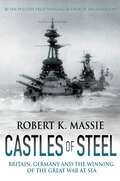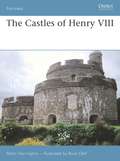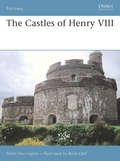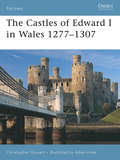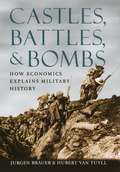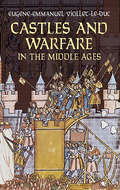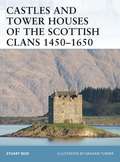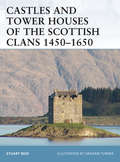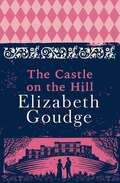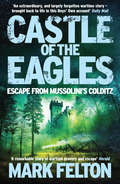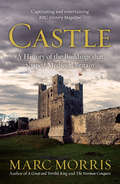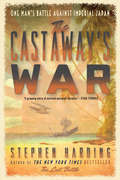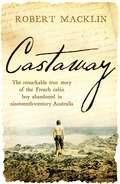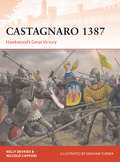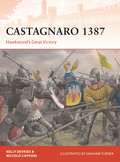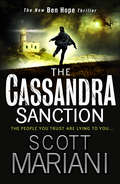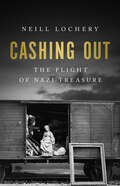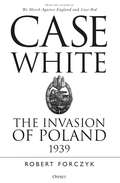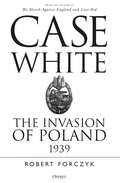- Table View
- List View
Castles of Steel: Britain, Germany and the Winning of the Great War at Sea
by Robert K. MassieOn the eve of the war in August 1914, Great Britain and Germany possessed the two greatest navies the world had ever seen: two fleets of dreadnoughts – gigantic 'castles of steel' able to hurl massive shells at an enemy miles away – were ready to test their terrible power against each other.They skirmished across the globe before Germany, suffocated by an implacable naval blockade, decided to definitively strike against the British ring of steel. The result was Jutland, a titanic clash of fifty-eight dreadnoughts, each holding of a thousand men. When the German High Seas Fleet retreated, the Kaiser unleashed unrestricted U-boat warfare, which, in its indiscriminate violence, brought a reluctant America into the war: the German effort to "seize the trident" led to the fall of the German empire. Massie's portrayals of Winston Churchill, the British admirals Fisher, Jellicoe, and Beatty, and the Germans Scheer, Hipper, and Tirpitz are stunning in their veracity and artistry.
The Castles of Henry VIII (Fortress #66)
by Peter Harrington Brian DelfIn the last years of his reign Henry VIII needed a radically modern system of defence to protect England and its new Church. Anticipating a foreign onslaught from Catholic Europe after his split from Rome, Henry energetically began construction of more than 20 stone forts to protect England's major ports and estuaries. Aided by excellent illustrations, Peter Harrington explores the departure from artillery-vulnerable medieval castle designs, to the low, sturdy stone fortresses inspired by European ideas. He explains the scientific care taken to select sites for these castles, and the transition from medieval to modern in this last surge of English castle construction.
The Castles of Henry VIII (Fortress #66)
by Peter Harrington Brian DelfIn the last years of his reign Henry VIII needed a radically modern system of defence to protect England and its new Church. Anticipating a foreign onslaught from Catholic Europe after his split from Rome, Henry energetically began construction of more than 20 stone forts to protect England's major ports and estuaries. Aided by excellent illustrations, Peter Harrington explores the departure from artillery-vulnerable medieval castle designs, to the low, sturdy stone fortresses inspired by European ideas. He explains the scientific care taken to select sites for these castles, and the transition from medieval to modern in this last surge of English castle construction.
The Castles of Edward I in Wales 1277–1307 (Fortress)
by Adam Hook Christopher GravettIn 1277 Edward I gathered a huge army and marched into Wales to subdue the rebel Welsh princes. A key part of his strategy was to erect a castle wherever his army rested. This title takes a detailed look at the design, development and principles of defence of these Welsh castles, documenting daily life within their walls and the historical events that took place around them. Focusing on key sites, it highlights the varied castle designs ranging from fortifications based on French models to the defences inspired by Constantinople, and is illustrated with eight pages of full-colour illustrations and cutaway artwork.
The Castles of Edward I in Wales 1277–1307 (Fortress #64)
by Adam Hook Christopher GravettIn 1277 Edward I gathered a huge army and marched into Wales to subdue the rebel Welsh princes. A key part of his strategy was to erect a castle wherever his army rested. This title takes a detailed look at the design, development and principles of defence of these Welsh castles, documenting daily life within their walls and the historical events that took place around them. Focusing on key sites, it highlights the varied castle designs ranging from fortifications based on French models to the defences inspired by Constantinople, and is illustrated with eight pages of full-colour illustrations and cutaway artwork.
Castles, Battles, and Bombs: How Economics Explains Military History
by Jurgen Brauer Hubert van TuyllCastles, Battles, and Bombs reconsiders key episodes of military history from the point of view of economics—with dramatically insightful results. For example, when looked at as a question of sheer cost, the building of castles in the High Middle Ages seems almost inevitable: though stunningly expensive, a strong castle was far cheaper to maintain than a standing army. The authors also reexamine the strategic bombing of Germany in World War II and provide new insights into France’s decision to develop nuclear weapons. Drawing on these examples and more, Brauer and Van Tuyll suggest lessons for today’s military, from counterterrorist strategy and military manpower planning to the use of private military companies in Afghanistan and Iraq. "In bringing economics into assessments of military history, [the authors] also bring illumination. . . . [The authors] turn their interdisciplinary lens on the mercenary arrangements of Renaissance Italy; the wars of Marlborough, Frederick the Great, and Napoleon; Grant's campaigns in the Civil War; and the strategic bombings of World War II. The results are invariably stimulating."—Martin Walker, Wilson Quarterly "This study is serious, creative, important. As an economist I am happy to see economics so professionally applied to illuminate major decisions in the history of warfare."—Thomas C. Schelling, Winner of the 2005 Nobel Prize in Economics
Castles, Battles, and Bombs: How Economics Explains Military History
by Jurgen Brauer Hubert van TuyllCastles, Battles, and Bombs reconsiders key episodes of military history from the point of view of economics—with dramatically insightful results. For example, when looked at as a question of sheer cost, the building of castles in the High Middle Ages seems almost inevitable: though stunningly expensive, a strong castle was far cheaper to maintain than a standing army. The authors also reexamine the strategic bombing of Germany in World War II and provide new insights into France’s decision to develop nuclear weapons. Drawing on these examples and more, Brauer and Van Tuyll suggest lessons for today’s military, from counterterrorist strategy and military manpower planning to the use of private military companies in Afghanistan and Iraq. "In bringing economics into assessments of military history, [the authors] also bring illumination. . . . [The authors] turn their interdisciplinary lens on the mercenary arrangements of Renaissance Italy; the wars of Marlborough, Frederick the Great, and Napoleon; Grant's campaigns in the Civil War; and the strategic bombings of World War II. The results are invariably stimulating."—Martin Walker, Wilson Quarterly "This study is serious, creative, important. As an economist I am happy to see economics so professionally applied to illuminate major decisions in the history of warfare."—Thomas C. Schelling, Winner of the 2005 Nobel Prize in Economics
Castles, Battles, and Bombs: How Economics Explains Military History
by Jurgen Brauer Hubert van TuyllCastles, Battles, and Bombs reconsiders key episodes of military history from the point of view of economics—with dramatically insightful results. For example, when looked at as a question of sheer cost, the building of castles in the High Middle Ages seems almost inevitable: though stunningly expensive, a strong castle was far cheaper to maintain than a standing army. The authors also reexamine the strategic bombing of Germany in World War II and provide new insights into France’s decision to develop nuclear weapons. Drawing on these examples and more, Brauer and Van Tuyll suggest lessons for today’s military, from counterterrorist strategy and military manpower planning to the use of private military companies in Afghanistan and Iraq. "In bringing economics into assessments of military history, [the authors] also bring illumination. . . . [The authors] turn their interdisciplinary lens on the mercenary arrangements of Renaissance Italy; the wars of Marlborough, Frederick the Great, and Napoleon; Grant's campaigns in the Civil War; and the strategic bombings of World War II. The results are invariably stimulating."—Martin Walker, Wilson Quarterly "This study is serious, creative, important. As an economist I am happy to see economics so professionally applied to illuminate major decisions in the history of warfare."—Thomas C. Schelling, Winner of the 2005 Nobel Prize in Economics
Castles, Battles, and Bombs: How Economics Explains Military History
by Jurgen Brauer Hubert van TuyllCastles, Battles, and Bombs reconsiders key episodes of military history from the point of view of economics—with dramatically insightful results. For example, when looked at as a question of sheer cost, the building of castles in the High Middle Ages seems almost inevitable: though stunningly expensive, a strong castle was far cheaper to maintain than a standing army. The authors also reexamine the strategic bombing of Germany in World War II and provide new insights into France’s decision to develop nuclear weapons. Drawing on these examples and more, Brauer and Van Tuyll suggest lessons for today’s military, from counterterrorist strategy and military manpower planning to the use of private military companies in Afghanistan and Iraq. "In bringing economics into assessments of military history, [the authors] also bring illumination. . . . [The authors] turn their interdisciplinary lens on the mercenary arrangements of Renaissance Italy; the wars of Marlborough, Frederick the Great, and Napoleon; Grant's campaigns in the Civil War; and the strategic bombings of World War II. The results are invariably stimulating."—Martin Walker, Wilson Quarterly "This study is serious, creative, important. As an economist I am happy to see economics so professionally applied to illuminate major decisions in the history of warfare."—Thomas C. Schelling, Winner of the 2005 Nobel Prize in Economics
Castles, Battles, and Bombs: How Economics Explains Military History
by Jurgen Brauer Hubert van TuyllCastles, Battles, and Bombs reconsiders key episodes of military history from the point of view of economics—with dramatically insightful results. For example, when looked at as a question of sheer cost, the building of castles in the High Middle Ages seems almost inevitable: though stunningly expensive, a strong castle was far cheaper to maintain than a standing army. The authors also reexamine the strategic bombing of Germany in World War II and provide new insights into France’s decision to develop nuclear weapons. Drawing on these examples and more, Brauer and Van Tuyll suggest lessons for today’s military, from counterterrorist strategy and military manpower planning to the use of private military companies in Afghanistan and Iraq. "In bringing economics into assessments of military history, [the authors] also bring illumination. . . . [The authors] turn their interdisciplinary lens on the mercenary arrangements of Renaissance Italy; the wars of Marlborough, Frederick the Great, and Napoleon; Grant's campaigns in the Civil War; and the strategic bombings of World War II. The results are invariably stimulating."—Martin Walker, Wilson Quarterly "This study is serious, creative, important. As an economist I am happy to see economics so professionally applied to illuminate major decisions in the history of warfare."—Thomas C. Schelling, Winner of the 2005 Nobel Prize in Economics
Castles, Battles, and Bombs: How Economics Explains Military History
by Jurgen Brauer Hubert van TuyllCastles, Battles, and Bombs reconsiders key episodes of military history from the point of view of economics—with dramatically insightful results. For example, when looked at as a question of sheer cost, the building of castles in the High Middle Ages seems almost inevitable: though stunningly expensive, a strong castle was far cheaper to maintain than a standing army. The authors also reexamine the strategic bombing of Germany in World War II and provide new insights into France’s decision to develop nuclear weapons. Drawing on these examples and more, Brauer and Van Tuyll suggest lessons for today’s military, from counterterrorist strategy and military manpower planning to the use of private military companies in Afghanistan and Iraq. "In bringing economics into assessments of military history, [the authors] also bring illumination. . . . [The authors] turn their interdisciplinary lens on the mercenary arrangements of Renaissance Italy; the wars of Marlborough, Frederick the Great, and Napoleon; Grant's campaigns in the Civil War; and the strategic bombings of World War II. The results are invariably stimulating."—Martin Walker, Wilson Quarterly "This study is serious, creative, important. As an economist I am happy to see economics so professionally applied to illuminate major decisions in the history of warfare."—Thomas C. Schelling, Winner of the 2005 Nobel Prize in Economics
Castles and Warfare in the Middle Ages
by M. Macdermott Eugene-Emmanuel Viollet-le-DucThis profusely illustrated and thoroughly researched book describes in detail the diverse methods used to attack and defend castles during the Middle Ages. In a groundbreaking study -- the first to shed light on the purpose, construction techniques, and effectiveness of medieval fortifications, noted nineteenth-century architect and writer Eugene-Emmanuel Viollet-le-Duc discusses such architectural elements as dungeons, keeps, battlements, and drawbridges. In addition to describing a vast number of European structures -- among them fortifications at Carcassonne, Paris, Avignon, Vincennes, Lubeck, Milan, and Nuremberg -- he examines the use of artillery and trenches, as well as such weapons as battering rams, mines, and the long-bow. A concise, scholarly reference for architectural historians, this absorbing history will appeal as well to medievalists, military buffs, and anyone interested in the evolution and development of the castle.
Castles and Tower Houses of the Scottish Clans 1450–1650 (Fortress)
by Stuart Reid Graham TurnerWith the exception of the key royal sites, such as Stirling and Edinburgh, few Scottish castles were located at strategic points, or were intended to house garrisons required to defend or subjugate towns. Instead they were primarily fortified dwelling houses, erected in an environment of weak Royal authority and endemic feuding between rival clans and groups, in both Highland and Lowland areas. Although some enceinte castles were developed during the 16th and 17th centuries, most defensive construction focused on the tower house, a distinctive vernacular style of Scottish fortification. This book examines the design, development, and purpose of these quintessentially Scottish buildings, and also covers larger sites such as Urquhart and Blackness.
Castles and Tower Houses of the Scottish Clans 1450–1650 (Fortress)
by Stuart Reid Graham TurnerWith the exception of the key royal sites, such as Stirling and Edinburgh, few Scottish castles were located at strategic points, or were intended to house garrisons required to defend or subjugate towns. Instead they were primarily fortified dwelling houses, erected in an environment of weak Royal authority and endemic feuding between rival clans and groups, in both Highland and Lowland areas. Although some enceinte castles were developed during the 16th and 17th centuries, most defensive construction focused on the tower house, a distinctive vernacular style of Scottish fortification. This book examines the design, development, and purpose of these quintessentially Scottish buildings, and also covers larger sites such as Urquhart and Blackness.
The Castle on the Hill
by Elizabeth GoudgeAmid the chaos of the Second World War comes a charming story of courage and friendship, from the author of Green Dolphin Country and A City of Bells.In the summer of 1940, as the darkest days of the Second World War approach, a chance encounter on a train leads Miss Brown to become housekeeper at the Castle.Hidden in a quiet, rural corner of England, the crumbling castle is home to lonely historian Mr Birley and his nephews, fighter pilot Richard and fair, peace-loving Stephen. With young evacuees Moppet and Poppet, and mysterious violinist Jo Isaacson, this unexpected family of strangers come to rely on each other as the devastations of war rage on.
Castle of the Eagles: Escape from Mussolini’s Colditz
by Mark FeltonHigh in the Tuscan hills above Florence, an elaborate medieval castle, converted to a POW camp on Mussolini’s personal orders, holds one of the most illustrious groups of prisoners in the history of warfare. The dozen or so British and Commonwealth senior officers includes three knights of the realm and two VCs. The youngest of them is 48, the oldest 63. One is missing a hand and an eye. Another suffers with a gammy hip. Against insuperable odds, these extraordinary middle-aged POWs plan a series of daring escape attempts, culminating in a complex tunnel deep beneath the castle. One rainswept night in March 1943, six men will burst from the earth beyond the castle’s curtain wall and slip away. By assorted means, the three Brits, two New Zealanders and a half-Belgian aristocrat will attempt to make it to neutral Switzerland, over 200 miles away.
Castle: A History of the Buildings that Shaped Medieval Britain (Paper Toy Ser.)
by Marc MorrisBeginning with their introduction in the eleventh century, and ending with their widespread abandonment in the seventeenth, Marc Morris explores many of the country’s most famous castles, as well as some spectacular lesser-known examples. At times this is an epic tale, driven by characters like William the Conqueror, King John and Edward I, full of sieges and conquest on an awesome scale. But it is also by turns an intimate story of less eminent individuals, whose adventures, struggles and ambitions were reflected in the fortified residences they constructed. Be it ever so grand or ever so humble, a castle was first and foremost a home.To understand castles – who built them, who lived in them, and why – is to understand the forces that shaped medieval Britain.
The Castaway's War: One Man's Battle against Imperial Japan
by Stephen HardingShipwrecked on a South Pacific island, a young US Navy lieutenant waged a one-man war against the JapaneseIn the early hours of July 5, 1943, the destroyer USS Strong was hit by a Japanese torpedo. The powerful weapon broke the destroyer's back, killed dozens of sailors, and sparked raging fires. While accompanying ships were able to take off most of Strong's surviving crewmembers, scores went into the ocean as the once-proud warship sank beneath the waves--and a young officer's harrowing story of survival began.Lieutenant Hugh Barr Miller, a pre-war football star at the University of Alabama, went into the water as the vessel sank. Severely injured, Miller and several others survived three days at sea and eventually landed on a Japanese-occupied island. The survivors found fresh water and a few coconuts, but Miller, suffering from internal injuries and believing he was on the verge of death, ordered the others to go on without him. They reluctantly did do, believing, as Miller did, that he would be dead within hours.But Miller didn't die, and his health improved enough for him to begin searching for food. He also found the enemy--Japanese forces patrolling the island. Miller was determined to survive, and so launched a one-man war against the island's occupiers.Based on official American and Japanese histories, personal memoirs, and the author's exclusive interviews with many of the story's key participants, The Castaway's War is a rousing story of naval combat, bravery, and determination.
Castaway: The remarkable true story of the French cabin boy abandoned in nineteenth-century Australia
by Robert Macklin'A truly remarkable account drawing upon a version Pelletier gave when he eventually returned to his native France and also on anthropological studies of the Daintree people.' Piers Akerman, Daily Telegraph, Sydney 'An unforgettable tale of transformation and upheaval.'Stuart McLean, Daily Telegraph, SydneyA young boy abandoned in an alien landscape thousands of miles from home is adopted by local people and becomes one of them, welcomed into their community, marrying a wife and raising a child. After seventeen years, he is stolen back to his 'real' life, where he has another family, but dreams constantly of what he has left behind.This is the remarkable true story of a French cabin boy Narcisse Pelletier who, after disembarking from his ship the Saint-Paul with the rest of its crew in search of drinking water, found himself separated from his shipmates and in the end abandoned on the north coast of Queensland, Australia. Narcisse was adopted by an Aboriginal group who welcomed him as one of their own for seventeen years, during which time he had a family of his own. In 1875, though, he was kidnapped by the brig John Bell and was returned eventually to his family in Saint-Gilles, France, where he became a lighthouse keeper. Robert Macklin makes skilful use of Narcisse's own memoir Chez les sauvages along with new research to tell this extraordinary story.Robert is a Queenslander so knows the terrain and the people of the area in which Narcisse was left behind. Through Noel Pearson's Cape York Institute, he has arranged to meet descendants of the people who took the French cabin boy in and who know the stories of his time in Australia. Robert has also had access to a great deal of material on the early history of the Cape through the Australian National Library. He has drawn on the significant resources of the Australian Institute of Aboriginal and Torres Strait Islander Studies (AIATSIS) in Canberra on Aboriginal culture and history in Queensland and the Cape. In addition, he has made use of Narcisse Pelletier's own writings, including his account of his time in Australia, as well as several contemporaneous accounts of the Kennedy expedition to the area, including one from a member of the party. The author has made several trips to Cape York and one to Saint-Gilles and Saint-Nazaire in France.
Castagnaro 1387: Hawkwood’s Great Victory (Campaign)
by Kelly DeVries Niccolò CapponiThe battle of Castagnaro, fought on 11 March 1387 between the Veronese and the Paduans, is one of the most famous Italian medieval conflicts in the English-speaking world. This is thanks in no small part to the exploits of the renowned English mercenary (or condottiero) captain, Sir John Hawkwood. Commanding the Paduan army, he led them to a stunning victory.This new study challenges the conventional story of the battle, relocating it to the other side of the Adige River, and showing that Hawkwood was no mere disciple of his previous commander, the Black Prince–he was a highly talented and intelligent general in his own right. Using specially commissioned full-colour artwork, this fascinating book shows how Hawkwood used his own acumen, and the training, skills, and discipline of his very experienced condottieri, to defeat his opponents at Castagnaro.
Castagnaro 1387: Hawkwood’s Great Victory (Campaign #337)
by Kelly DeVries Niccolò CapponiThe battle of Castagnaro, fought on 11 March 1387 between the Veronese and the Paduans, is one of the most famous Italian medieval conflicts in the English-speaking world. This is thanks in no small part to the exploits of the renowned English mercenary (or condottiero) captain, Sir John Hawkwood. Commanding the Paduan army, he led them to a stunning victory.This new study challenges the conventional story of the battle, relocating it to the other side of the Adige River, and showing that Hawkwood was no mere disciple of his previous commander, the Black Prince–he was a highly talented and intelligent general in his own right. Using specially commissioned full-colour artwork, this fascinating book shows how Hawkwood used his own acumen, and the training, skills, and discipline of his very experienced condottieri, to defeat his opponents at Castagnaro.
The Cassandra Sanction (Ben Hope #12)
by Scott MarianiTHE MOST SHOCKING ADVENTURE YET FROM THE #1 BESTSELLING AUTHOR ‘Deadly conspiracies, bone-crunching action and a tormented hero with a heart . . . packs a real punch’ Andy McDermott
Cashing Out: The Flight of Nazi Treasure, 1945–1948
by Neill LocheryWhen Nazis looked to flee Europe with stolen art, gems, and gold in tow, certain &“neutral&” countries were all too willing to assist them. By the end of January 1945, it was clear to Germany that the war was lost. The Third Reich was in freefall, and its leaders, apart from those clustered around Hitler in his Berlin bunker, sought to abscond before they were besieged. But they wanted to take their wealth with them. Their escape routes were diverse: Sweden and Switzerland boasted proximity, banking, and industrial closeness, while Spain and Portugal offered an inviting Atlantic coastline and shipping routes to South America. And in various ways, each of these so-called neutral nations welcomed the Nazi escapees, along with the clandestine wealth they carried. Cashing Out tells the riveting history of the race to intercept the stolen assets before they disappeared, and before the will to punish Germany was replaced by the political considerations of the fast-approaching Cold War. Bestselling author Neill Lochery here brilliantly recounts the flight of the Nazi-looted riches—the last great escape of World War II—and the Allied quest for justice.
Case White: The Invasion of Poland 1939
by Robert ForczykThe German invasion of Poland on 1 September, 1939, designated as Fall Weiss (Case White), was the event that sparked the outbreak of World War II in Europe. The campaign has widely been described as a textbook example of Blitzkrieg, but it was actually a fairly conventional campaign as the Wehrmacht was still learning how to use its new Panzers and dive-bombers. The Polish military is often misrepresented as hopelessly obsolete and outclassed by the Wehrmacht, when in fact it was well-equipped with modern weapons and armour. Indeed, the Polish possessed more tanks than the British and had cracked the German Enigma machine cipher. Though the combined assault from Germany and the Soviet Union defeated Poland, it could not crush the Polish fighting spirit and thousands of soldiers and airmen escaped to fight on other fronts. The result of Case White was a brutal occupation, as Polish Slavs found themselves marginalized and later eliminated, paving the way for Hitler's vision of Lebensraum (living space) and his later betrayal and invasion of the Soviet Union in 1941. Using a wide array of sources, Robert Forczyk challenges the myths of Case White to tell the full story of the invasion that sparked history's greatest conflict.
Case White: The Invasion of Poland 1939
by Robert ForczykThe German invasion of Poland on 1 September, 1939, designated as Fall Weiss (Case White), was the event that sparked the outbreak of World War II in Europe. The campaign has widely been described as a textbook example of Blitzkrieg, but it was actually a fairly conventional campaign as the Wehrmacht was still learning how to use its new Panzers and dive-bombers. The Polish military is often misrepresented as hopelessly obsolete and outclassed by the Wehrmacht, when in fact it was well-equipped with modern weapons and armour. Indeed, the Polish possessed more tanks than the British and had cracked the German Enigma machine cipher. Though the combined assault from Germany and the Soviet Union defeated Poland, it could not crush the Polish fighting spirit and thousands of soldiers and airmen escaped to fight on other fronts. The result of Case White was a brutal occupation, as Polish Slavs found themselves marginalized and later eliminated, paving the way for Hitler's vision of Lebensraum (living space) and his later betrayal and invasion of the Soviet Union in 1941. Using a wide array of sources, Robert Forczyk challenges the myths of Case White to tell the full story of the invasion that sparked history's greatest conflict.
